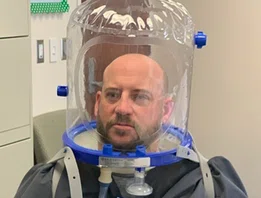


Outcomes Research
Houston Methodist-developed algorithm may
improve management and outcomes in critically ill COVID-19 patients

In the United States, physical therapy (PT) is commonly administered to patients in the intensive care unit (ICU) since these patients suffer from weakness, fatigue and poor functional status. Physical therapists play a fundamental role in improving the quality of life of ICU patients during their recovery from critical illnesses. The COVID-19 surge between March and May 2020 in Houston caused several cardiovascular, neurological and musculoskeletal symptoms in patients. Patients with COVID-19 in the ICU suffered from these symptoms and were at risk for reduced functional mobility, reduced quality of life, increased mortality and increased risk for developing post-intensive care syndrome and ICU-acquired weakness.
At the beginning of the pandemic, PT intervention appeared to be limited in the ICU and primarily focused on proning, range of motion and bed exercises. After discussions with clinicians in other hospitals, review of the literature and patient observation, Catherine Stolboushkin, PT, DPT, CCS at the Houston Methodist Rehabilitation Services noticed that the patients with COVID-19 in the ICU could endure more intensive physical therapy intervention than anticipated. However, some of these patients were outside the normal parameters for initiating PT intervention and continuing mobility exercises – which presented a unique clinical challenge. This suggested a gap in the literature regarding the clinical decision-making process needed to provide safe and effective PT intervention at the bedside to ICU patients.

Catherine Stolboushkin,
PT, DPT, CCS
To describe the physical therapy practice in critically ill patients with COVID-19 at a tertiary care hospital such as Houston Methodist and to outline a novel clinical decision-making algorithm (nCDM) and its applications in improving clinical practice for this patient population, Stolboushkin performed a retrospective chart review, the results of which were published in the Cardiopulmonary Physical Therapy Journal in 2021. This study entailed selection and evaluation of PT and demographic data and clinical records of patients with COVID-19 admitted to Houston Methodist Hospital ICUs with a PT consultation between March and May 2020. The inclusion criteria were a positive COVID-19 test during hospital admission, referral for PT while in the ICU, ability to actively participate in PT and acceptable medical stability. Before the pandemic, early physical therapy consultation and interdisciplinary rounding assigned patients to either nursing, PT or mobility technician care using the ICU Liberation ABCDEF bundle. The COVID-19 surge challenged health-care professionals to adjust best practices and become creative.
Physical therapy intervention is an integral component of a patient’s course for recovery during and after critical illness due to COVID-19. This algorithm allowed us to provide PT intervention for patients who may not have been seen or for whom intervention may have been delayed based on our previous guidelines. Further research needs to be done on the safety and feasibility of using this clinical decision-making algorithm for patients with COVID-19 or other similar respiratory impairments.
Catherine Stolboushkin, PT, DPT, CCS
Houston Methodist Rehabilitation Services
After a review of clinical experiences gained during the pandemic, the literature and discussions with intensivists and respiratory therapists, Stolboushkin extrapolated the current clinical decision-making process to develop the nCDM to establish a new standard PT practice for patients with COVID-19 in the ICU.
In this study, ICU PT evaluations included measurement of several parameters including the Activity Measure for Post-Acute Care “6 clicks” (AM-PAC), the Perme ICU Mobility Score, Medical Research Council Sum Score, Richmond Agitation-Sedation Scale and Barthel Index. Since the COVID-19 virus affects the respiratory system, additional parameters included partial pressure of oxygen in arterial blood (PaO2), fraction of inspired oxygen (FiO2), positive and expiratory pressure (PEEP) and PaO2/FiO2 ratio (P/F ratio).
The AM-PAC measures the functional mobility of the patient and determines activity limitations based on the World Health Organization’s International Classification of Functioning, Disability and Health. Between March and May 2020, 247 patients with COVID-19 were admitted to the ICU, out of which 104 patients received PT consultation and 77 received PT services. In the patient population that was evaluated, the AM-PAC scores showed a statistically significant improvement between the initial evaluation and the final PT evaluation before discharge.
Notably, 26 of the 77 patients were outside previously established parameters for initiating PT intervention and continuing mobility. Stolboushkin obtained positive results on functional parameters in this patient population in spite of high respiratory support, various sedation levels, and fluctuating hemodynamic status.
According to Stolboushkin, “Physical therapy intervention is an integral component of a patient’s course for recovery during and after critical illness due to COVID-19. This algorithm allowed us to provide PT intervention for patients who may not have been seen or for whom intervention may have been delayed based on our previous guidelines. Further research needs to be done on the safety and feasibility of using this clinical decision-making algorithm for patients with COVID-19 or other similar respiratory impairments.”
This retrospective chart review was the first to describe PT practice for critically ill patients with COVID-19 in the ICU – with or without mechanical ventilation. The clinical decision-making algorithm described here can be extrapolated to other ailments and ICU settings. Moreover, this study pushed the envelope with the patient tolerance and mobility of PT intervention.
Conversely, caution should be exercised when drawing conclusions from this study as the authors did not pinpoint PT to be the sole reason behind improvements in the functional mobility of the patient. Also, the sample size was small and the patient population only included adults suffering from COVID-19 during the first surge of the pandemic in Houston.
Taken together, the novel algorithm developed by Stolboushkin can help clinicians identify patient populations suitable for PT intervention as well as the optimum time of PT intervention to maximize the safety and quality of life of COVID-19 ICU patients. Future studies with larger sample sizes should add to this body of knowledge and verify if these results can be replicated in other facilities. Additionally, novel clinical decision-making processes may be applied to diseases other than COVID-19 such as acute respiratory distress syndrome.
Stolboushkin, Catherine; Mondkar, Rajashree; Schwing, Terrence; Belarmino, Bobby. Physical Therapy Practice for Critically Ill Patients With COVID-19 in the Intensive Care Unit. Cardiopulmonary Physical Therapy Journal: September 30, 2021 - Volume - Issue -doi: 10.1097/CPT.0000000000000188
Abanti Chattopadhyay, PhD, January 2022








